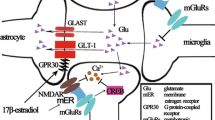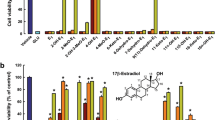Abstract
The original neuroprotective hypothesis of estrogen was based on the gender difference in brain response to the ischemia-reperfusion injury. Additional clinical reports also suggest that estrogen may improve cognition in patients with Alzheimer disease. 17β-Estradiol is the most potent endogenous ligand of estrogen, which protects against neurodegeneration in both cell and animal models. Estrogen-mediated neuroprotection is probably mediated by both receptor-dependent and -independent mechanisms. Binding of estrogen such as 17β-estradiol to estrogen receptors (ERs) activates the homodimers of ER-DNA and its binding to estrogen response elements in the promoter region of genes such as neuronal nitric oxide synthase (NOS1) for regulating gene expression in target brain cells. In addition to the induction of NOS1, estrogen increases the expression of antiapoptotic protein such as bcl-2. Furthermore, our recent observations provide new molecular biologic and pharmacologic evidence suggesting that physiologic concentrations of 17β-estradiol (<10 nM) activate ERs (ERβ >ERα) and upregulate a cyclic guanosine 5′-monophosphate (cGMP)-dependent thioredoxin (Trx) and MnSOD expression following the induction of NOS1 in human brain-derived SH-SY5Y cells. We thus proposed that the estrogen-mediated gene induction of Trx plays a pivotal role in the promotion of neuroprotection because Trx is a multifunctional antioxidative and antiapoptotic protein. For managing progressive neurodegeneration such as Alzheimer dementia, our estrogen proposal of the signaling pathway of cGMP-dependent protein kinase (PKG) in mediating estrogen-induced cytoprotective genes thus fosters research and development of the new estrogen ligands devoid of female hormonal side effects such as carcinogenesis.
Similar content being viewed by others
References
Belcher, S. M. (1999). Brain Res. Dev. Brain Res. 115, 57–69.
McEwen, B., Akama, K., Alves, S., et al. (2001). Proc. Natl. Acad. Sci. USA 98, 7093–7100.
Wang, L., Andersson, S., Warner, M., and Gustafsson, J. A. (2001). Proc. Natl. Acad. Sci. USA 98, 2792–2796.
Patrone, C., Pollio, G., Vegeto, E., et al. (2000). Endocrinology 141, 1839–1845.
Dubal, D. B., Zhu, H., Yu, J., et al. (2001). Proc. Natl. Acad. Sci. USA 98, 1952–1957.
Jover, T., Tanaka, H., Calderone, A., et al. (2002). J. Neurosci. 22, 2115–2124.
Geary, G. G., McNeil, A. M., Ospina, J. A., Krause, D. N., Korach, K. S., and Duclles, S. P. (2001). J. Appl. Physiol. 91, 2391–2399.
Howell, A., Osborne, C. K., Morris, C., and Wakeling, A. E. (2000). Cancer 89, 817–825.
Lee, S. Y., Andoh, T., Murphy, D. L., and Chiueh, C. C. (2003). FASEB J. Express. 10.1096/fj.02-0807fje.
Nishiyama, A., Matsui, M., Iwata, S., et al. (1999). J. Biol. Chem. 274, 21645–21650.
Paech, K., Webb, P., Kuiper, G. G., et al. (1997). Science 277, 1508–1510.
Nuedling, S., Karas, R. H., Mendelsohn, M. E., et al. (2001). FEBS Lett. 502, 103–108.
Fillit, H., Weinreb, H., Cholst, I., et al. (1986). Psychoneuroendocrinology 11, 337–345.
Shumaker, S. A., Reboussin, B. A., Espeland, M. A., et al. (1998). Control Clin. Trials 19, 604–621.
Asthana, S., Baker, L. D., Craft, S., et al. (2001). Neurology 57, 605–612.
Green, P. S., Bishop, J., and Simpkins, J. W. (1997). J. Neurosci. 17, 511–515.
Kim, H., Bang, O. Y., Jung, M. W., et al. (2001). Neurosci. Lett. 302, 58–62.
Kuroki, Y., Fukushima, K., Kanda, Y., Mizuno, K., and Watanabe, Y. (2001). Eur. J. Neurosci. 13, 472–476.
Berco, M. and Bhavnani, B. R. (2001). J. Soc. Gynecol. Invest. 8, 245–254.
Hawkins, V., Shen, Q., and Chiueh, C. C. (1999). J. Biomed. Sci. 6, 433–438.
Howard, S. A., Brooke, S. M., and Sapolsky, R. M. (2001). Exp. Neurol. 168, 385–391.
Sawada, H., Ibi, M., Kihara, T., et al. (2002). Neuropharmacology 42, 1056–1064.
Wang, L., Andersson, S., Warner, M., and Gustafsson, J. A. (2002). Sci. STKE 138, 1–4.
Hall, E. D., Pazara, K. E., and Linseman, K. L. (1991). J. Cereb. Blood Flow Metab. 11, 292–298.
Roof, R. L. and Hall, E. D. (2000). J. Neurotrauma 17, 367–388.
Garcia-Segura, L. M., Azcoitia, I., and Doncarlos, L. L. (2001). Prog. Neurobiol. 63, 29–60.
Wise, P. M., Dubal, D. B., Wilson, M. E., Rau, S. W., and Bottner, M. (2001). Endocrinology 142, 969–973.
Bruce-Keller, A. J., Keeling, J. L., Keller, J. N., Huang, F. F., Camondola, S., and Mattson, M. P. (2000). Endocrinology 141, 3646–3656.
Rauhala, P. and Chiueh, C. C. (2000). Ann. NY Acad. Sci. 899, 238–254.
Green, P. S., Yang, S. H., and Simpkins, J. W. (2000). Novartis Found. Symp. 230, 202–213.
Ivanova, T., Kuppers, E., Engele, J., and Beyer, C. (2001). J. Neurosci. Res. 66, 221–230.
Singleton, J. R., Randolph, A. E., and Feldman, E. L. (1996). Cancer Res. 56, 4522–4529.
Dubal, D. B., Shughrue, P. J., Wilson, M. E., Merchenthaler, I., and Wise, P. M. (1999). J. Neurosci. 19, 6385–6393.
Stoltzner, S. E., Berchtold, N. C., Cotman, C. W., and Pike, C. J. (2001). Neuroreport 12, 2797–2800.
Sawada, H., Ibi, M., Kihara, T., et al. (2000). FASEB J. 14, 1202–1214.
Paech, K., Webb, P., Kuiper, G. G., et al. (1997). Science 277, 1508–1510.
Harms, C., Lautenschlager, M., Bergk, A., et al. (2001). J. Neurosci. 21, 2600–2609.
Weiner, C. P., Lizasoain, I., Baylis, S. A., Knowles, R. G., Charles, I. G., and Moncada, S. (1994). Proc. Natl. Acad. Sci. USA 91, 5212–5216.
Pelligrino, D. A., Santizo, R., Baughman, V. L., and Wang, Q. (1998). Neuroreport 9, 3285–3291.
Garcia-Duran, M., de Frutos, T., Diaz-Recasens, J., et al. (1999). Circ. Res. 85, 1020–1026.
Andoh, T., Chock, P. B., and Chiueh, C. C. (2002). J. Biol. Chem. 277, 9655–9660.
Andoh, T., Chock, P. B., and Chiueh, C. C. (2002). Ann. NY Acad. Sci. 962, 1–7.
Andoh, T., Chiueh, C. C., and Chock, P. B. (2003). J. Biol. Chem. 278, 885–890.
Andoh, T., Lee, S. Y., and Chiueh, C. C. (2000). FASEB J. 14, 2144–2146.
Estevez, A. G., Spear, N., Thompson, J. A., et al. (1998). J. Neurosci. 18, 3708–3714.
Kim, Y. M., Chung, H. T., Kim, S. S., et al. (1999). J. Neurosci. 19, 6740–6747.
Wirtz-Brugger, F. and Giovanni, A. (2000). Neuroscience 99, 737–750.
Takuma, K., Phuagphong, P., Lee, E., Mori, K., Baba, A., and Matsuda, T. (2001). J. Biol. Chem. 276, 48093–48099.
Takagi, Y., Mitsui, A., Nishiyama, A., et al. (1999). Proc. Natl. Acad. Sci. USA 96, 4131–4136.
Holmgren, A. (2000). Antioxid. Redox Signal 2, 811–820.
Liu, H., Nishitoh, H., Ichijo, H., and Kyriakis, J. M. (2000). Mol. Cell Biol. 20, 2198–2208.
Hayashi, T., Ueno, Y., and Okamoto, T. (1993). J. Biol. Chem. 268, 11380–11388.
Saitoh, M., Nishitoh, H., Fujii, M., et al. (1998). EMBO J. 17, 2596–2606.
Hirota, K., Matsui, M., Iwata, S., Nishiyama, A., Mori, K., and Yodoi, J. (1997). Proc. Natl. Acad. Sci. USA 94, 3633–3638.
Ueno, M., Masutani, H., Arai, R. J., et al. (1999). J. Biol. Chem. 274, 35809–35815.
Haendeler, J., Hoffman, J., Tischler, V., Berk, B. C., Zeiher, A. M., and Dimmeler, S. (2002). Nat. Cell Biol. 4, 743–749.
Das, K. C., Lewis-Molock, Y., and White, C. W. (1997). Am. J. Respir. Cell Mol. Biol. 17, 713–726.
Bai, J., Nakamura, H., Kwon, Y.-W. et al. (2003). J. Neurosci. 23, 503–509.
Behl, C., Skutella, T., Lezoualc’h, F., et al. (1997). Mol. Pharmacol. 51, 535–541.
Chiueh, C. C. and Andoh, T. (2001). In: Mapping the progress of Alzheimer’s and Parkinson’s disease. (Mizuno, Y., Fisher, A., and Hanin, I. (eds.). Kluwer Academic/Plenum: New York.
Author information
Authors and Affiliations
Corresponding author
Rights and permissions
About this article
Cite this article
Chiueh, C.C., Lee, S.Y., Andoh, T. et al. Induction of antioxidative and antiapoptotic thioredoxin supports neuroprotective hypothesis of estrogen. Endocr 21, 27–31 (2003). https://doi.org/10.1385/ENDO:21:1:27
Received:
Revised:
Accepted:
Issue Date:
DOI: https://doi.org/10.1385/ENDO:21:1:27




